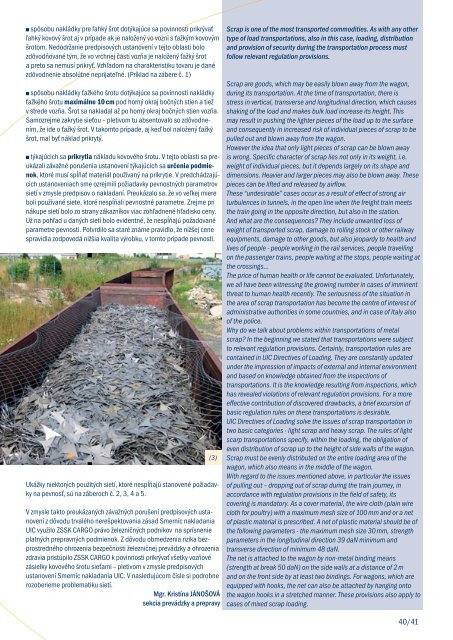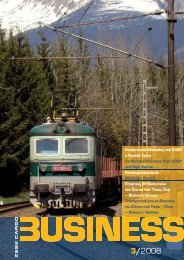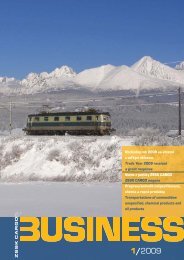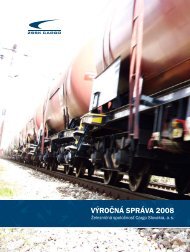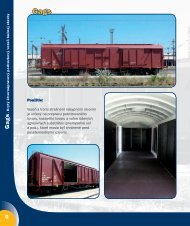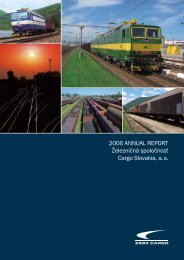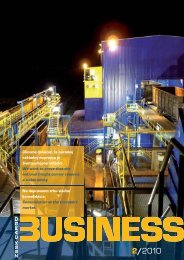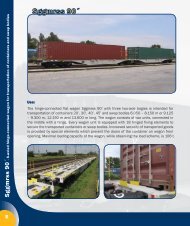CARGO BUSINESS 3-09.indd - ZSSK Cargo
CARGO BUSINESS 3-09.indd - ZSSK Cargo
CARGO BUSINESS 3-09.indd - ZSSK Cargo
Create successful ePaper yourself
Turn your PDF publications into a flip-book with our unique Google optimized e-Paper software.
spôsobu nakládky pre ľahký šrot dotýkajúce sa povinnosti prikrývať<br />
ľahký kovový šrot aj v prípade ak je naložený vo vozni s ťažkým kovovým<br />
šrotom. Nedodržanie predpisových ustanovení v tejto oblasti bolo<br />
zdôvodňované tým, že vo vrchnej časti vozňa je naložený ťažký šrot<br />
a preto sa nemusí prikryť. Vzhľadom na charakteristiku tovaru je dané<br />
zdôvodnenie absolútne neprijateľné. (Príklad na zábere č. 1)<br />
spôsobu nakládky ťažkého šrotu dotýkajúce sa povinnosti nakládky<br />
ťažkého šrotu maximálne 10 cm pod horný okraj bočných stien a tiež<br />
v strede vozňa. Šrot sa nakladal až po horný okraj bočných stien vozňa.<br />
Samozrejme zakrytie sieťou – pletivom tu absentovalo so zdôvodnením,<br />
že ide o ťažký šrot. V takomto prípade, aj keď bol naložený ťažký<br />
šrot, mal byť náklad prikrytý.<br />
týkajúcich sa prikrytia nákladu kovového šrotu. V tejto oblasti sa preukázali<br />
závažné porušenia ustanovení týkajúcich sa určenia podmienok,<br />
ktoré musí spĺňať materiál používaný na prikrytie. V predchádzajúcich<br />
ustanoveniach sme ozrejmili požiadavky pevnostných parametrov<br />
sietí v zmysle predpisov o nakladaní. Preukázalo sa, že vo veľkej miere<br />
boli používané siete, ktoré nespĺňali pevnostné parametre. Zrejme pri<br />
nákupe sietí bolo zo strany zákazníkov viac zohľadnené hľadisko ceny.<br />
Už na pohľad u daných sietí bolo evidentné, že nespĺňajú požadované<br />
parametre pevnosti. Potvrdilo sa staré známe pravidlo, že nižšej cene<br />
spravidla zodpovedá nižšia kvalita výrobku, v tomto prípade pevnosti.<br />
(3)<br />
Ukážky niektorých použitých sietí, ktoré nespĺňajú stanovené požiadavky<br />
na pevnosť, sú na záberoch č. 2, 3, 4 a 5.<br />
V zmysle takto preukázaných závažných porušení predpisových ustanovení<br />
z dôvodu trvalého nerešpektovania zásad Smerníc nakladania<br />
UIC využilo <strong>ZSSK</strong> <strong>CARGO</strong> právo železničných podnikov na sprísnenie<br />
platných prepravných podmienok. Z dôvodu obmedzenia rizika bezprostredného<br />
ohrozenia bezpečnosti železničnej prevádzky a ohrozenia<br />
zdravia pristúpilo <strong>ZSSK</strong> <strong>CARGO</strong> k povinnosti prikrývať všetky vozňové<br />
zásielky kovového šrotu sieťami – pletivom v zmysle predpisových<br />
ustanovení Smerníc nakladania UIC. V nasledujúcom čísle si podrobne<br />
rozoberieme problematiku sietí.<br />
Mgr. Kristína JÁNOŠOVÁ<br />
sekcia prevádzky a prepravy<br />
Scrap is one of the most transported commodities. As with any other<br />
type of load transportations, also in this case, loading, distribution<br />
and provision of security during the transportation process must<br />
follow relevant regulation provisions.<br />
Scrap are goods, which may be easily blown away from the wagon,<br />
during its transportation. At the time of transportation, there is<br />
stress in vertical, transverse and longitudinal direction, which causes<br />
shaking of the load and makes bulk load increase its height. This<br />
may result in pushing the lighter pieces of the load up to the surface<br />
and consequently in increased risk of individual pieces of scrap to be<br />
pulled out and blown away from the wagon.<br />
However the idea that only light pieces of scrap can be blown away<br />
is wrong. Specific character of scrap lies not only in its weight, i.e.<br />
weight of individual pieces, but it depends largely on its shape and<br />
dimensions. Heavier and larger pieces may also be blown away. These<br />
pieces can be lifted and released by airflow.<br />
These “undesirable” cases occur as a result of effect of strong air<br />
turbulences in tunnels, in the open line when the freight train meets<br />
the train going in the opposite direction, but also in the station.<br />
And what are the consequences? They include unwanted loss of<br />
weight of transported scrap, damage to rolling stock or other railway<br />
equipments, damage to other goods, but also jeopardy to health and<br />
lives of people - people working in the rail services, people travelling<br />
on the passenger trains, people waiting at the stops, people waiting at<br />
the crossings...<br />
The price of human health or life cannot be evaluated. Unfortunately,<br />
we all have been witnessing the growing number in cases of imminent<br />
threat to human health recently. The seriousness of the situation in<br />
the area of scrap transportation has become the centre of interest of<br />
administrative authorities in some countries, and in case of Italy also<br />
of the police.<br />
Why do we talk about problems within transportations of metal<br />
scrap? In the beginning we stated that transportations were subject<br />
to relevant regulation provisions. Certainly, transportation rules are<br />
contained in UIC Directives of Loading. They are constantly updated<br />
under the impression of impacts of external and internal environment<br />
and based on knowledge obtained from the inspections of<br />
transportations. It is the knowledge resulting from inspections, which<br />
has revealed violations of relevant regulation provisions. For a more<br />
effective contribution of discovered drawbacks, a brief excursion of<br />
basic regulation rules on these transportations is desirable.<br />
UIC Directives of Loading solve the issues of scrap transportation in<br />
two basic categories - light scrap and heavy scrap. The rules of light<br />
scarp transportations specify, within the loading, the obligation of<br />
even distribution of scrap up to the height of side walls of the wagon.<br />
Scrap must be evenly distributed on the entire loading area of the<br />
wagon, which also means in the middle of the wagon.<br />
With regard to the issues mentioned above, in particular the issues<br />
of pulling out – dropping out of scrap during the train journey, in<br />
accordance with regulation provisions in the field of safety, its<br />
covering is mandatory. As a cover material, the wire cloth (plain wire<br />
cloth for poultry) with a maximum mesh size of 100 mm and or a net<br />
of plastic material is prescribed. A net of plastic material should be of<br />
the following parameters - the maximum mesh size 30 mm, strength<br />
parameters in the longitudinal direction 39 daN minimum and<br />
transverse direction of minimum 48 daN.<br />
The net is attached to the wagon by non-metal binding means<br />
(strength at break 50 daN) on the side walls at a distance of 2 m<br />
and on the front side by at least two bindings. For wagons, which are<br />
equipped with hooks, the net can also be attached by hanging onto<br />
the wagon hooks in a stretched manner. These provisions also apply to<br />
cases of mixed scrap loading.<br />
40/41


